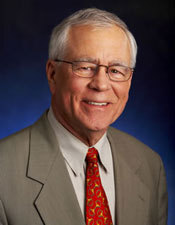por
Brendon Nafziger, DOTmed News Associate Editor | December 01, 2011

William Hendee (Credit: AAPM)
Americans are exposed to more medical radiation than ever before. And for William Hendee, that's a good thing.
"Ladies and gentlemen, this is terrifically good news," the distinguished medical physicist told attendees during a talk Wednesday at the Radiological Society of North America's 2011 meeting in Chicago.
In his lecture, "Risks in Medical Imaging: Separating Fact from Fantasy," Hendee, who edits the journal Medical Physics and won a Gold Medal from RSNA four years ago, said the increase in medical radiation -- 0.54 millisieverts per capita in 1982 to 3.0 mSv per capita in 2006 -- likely means patients are undergoing more imaging with ionizing radiation because technological advances have made it more useful to their lives.




Ad Statistics
Times Displayed: 40568
Times Visited: 1128 Stay up to date with the latest training to fix, troubleshoot, and maintain your critical care devices. GE HealthCare offers multiple training formats to empower teams and expand knowledge, saving you time and money
And while he said radiologists should strive to use the lowest reasonably achievable dose, Hendee aimed to pour cold water on fears brought about by studies that predict exposure to low-level radiation -- below 100 mSv -- is causing thousands of cancers nationwide.
Reality of the risk
Several recent studies have made dire, and headline-grabbing, predictions about the rise in medical imaging in the United States. For example, an Archives of Internal Medicine article from 2009 cited by Hendee estimated that use of CT scans in 2007 alone will trigger 29,000 future cancers. Also, in a famous recent study, researchers estimated that 1.5 to 2 percent of cancers in the U.S. are caused by CT exams.
But Hendee said these sorts of predictions founder for two main reasons: they're often based on inappropriately extrapolated data, and they assume a radiation risk model that might be fit for setting safety standards, but cannot be used to estimate population risks.
"We have no data that's solid enough to support these predictions, and that makes these predictions highly suspect," he said.
For one, the source of much of the data on radiation's biological effects on humans comes from studying atomic bomb survivors in Japan. Unlike patients undergoing a CT or nuclear medicine scan, who are generally only exposed to low energy X-rays and gamma rays concentrated on a small region of the body, the A-bomb survivors received whole-body, instantaneous exposure from high and low energy gamma rays, neutrons, particles and fallout, Hendee said. Also, because of the ongoing war, they were generally malnourished and did not have access to adequate medical care -- thus, he said, they're not really a comparable population for pampered 21st century Americans receiving CT scans.




Steve Arey
No data makes for a good excuse
December 01, 2011 08:12
In 2007 the National Toxicology Institute's Report to Congress placed Ionizing Radiation on the Known Causes of Cancer in Humans. Of course we are already aware of that, just how much you say.?
Maybe a 676 pg. research report "Radiation from Medical Procedures in the Pathogenesis of Cancer" will give you a Reality Check. Library of Congress Catalog Number (LCCN) 99-045096
PURPOSE:
"X-rays have been a well-established cause of human Cancer for decades. This monograph was undertaken (a) to quantify what share of U.S. age-adjusted cancer mortality, for each gender, is caused by medical radiation, and (b) to check on the author's 1995 finding, based on completely different data, that exposure to medical radiation accounts for about 75% of Breast Cancer incidence in the USA. In the process of evaluating cancer mortality vs. non-cancer mortality for this monograph, it became obvious that the impact of medical radiation upon death-rates specifically from Ischemic Heart Disease also demanded evaluation."
to rate and post a comment